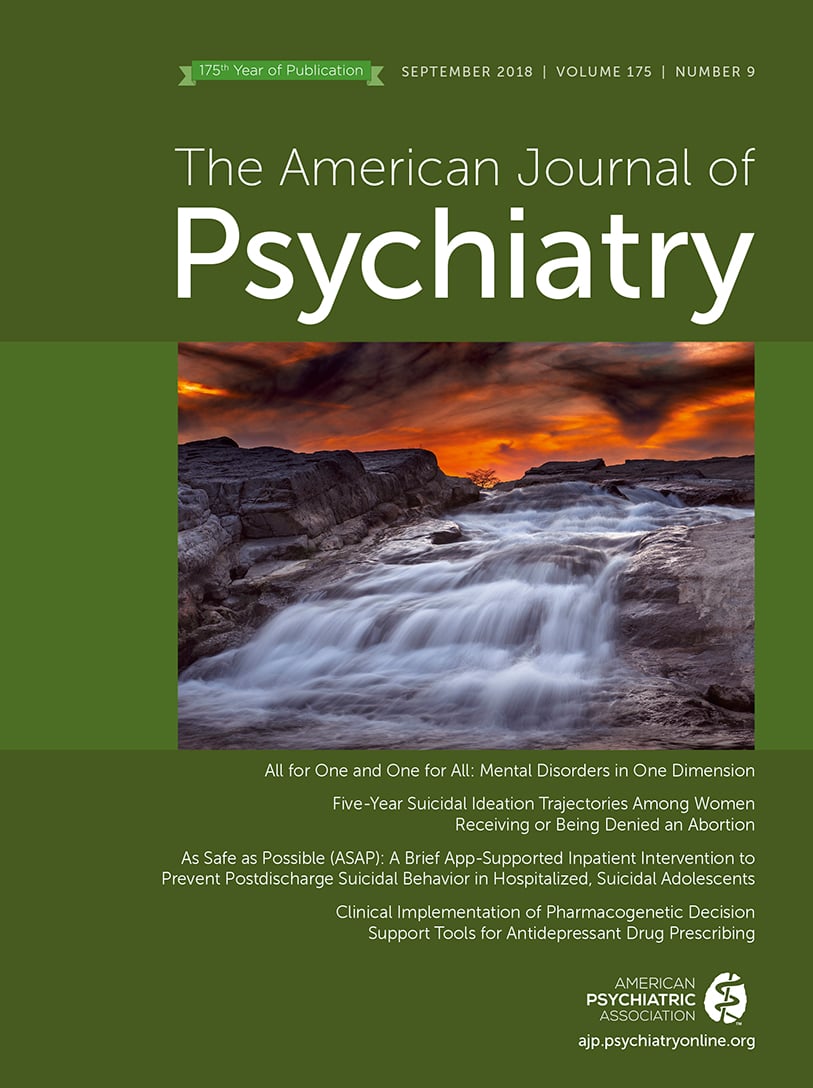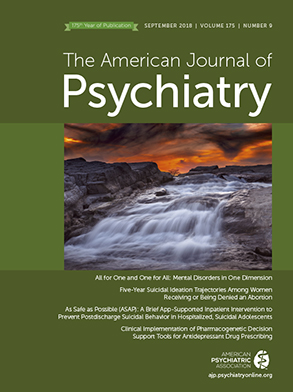In this issue of the
Journal, Kennard et al. (
1) report on an innovative treatment development trial designed to address the tragic problem of suicide, reverse the pattern of increasing rates of deaths by suicide among young people, and help achieve our national and global goal of reducing the number of deaths by suicide. This randomized controlled trial focuses on youths who were psychiatrically hospitalized for suicide attempts or suicidal ideation, with the aim of reducing the risk of suicide attempts and episodes of serious suicidal ideation during the high-risk period after hospital discharge. This randomized controlled trial compares a technology-enhanced intervention, designed to reduce rates of suicide attempts and suicidal ideation, with treatment as usual. The technology-enhanced intervention had two major components: 1) a four-module in-person cognitive-behavioral therapy (CBT) intervention that combined skills training with motivational enhancement delivered during hospitalization (over about three sessions), followed by telephone contacts at 1 and 2 weeks after discharge to support safety plans, skills, and app use as well as linkage to recommended care and 2) a Health Insurance Portability and Accountability Act-compliant telephone app that provided daily texts requesting youths to rate their levels of emotional distress and that offered personalized distress tolerance and emotion regulation skills based on the initial CBT and allowed youths to upload materials to support skill use (e.g., photographs). When youths experienced severe distress, the safety plan developed during in-person CBT was presented and included clinicians as well as others who could be contacted. Differences between the treatment as usual and technology-enhanced intervention groups were not statistically significant on the primary outcome of suicide attempts or the secondary outcome of suicidal ideation, although the direction of observed effects suggested a possible advantage for the technology-enhanced intervention in reducing suicide attempts and time to suicide attempts. Unfortunately, this small treatment-development randomized controlled trial was adequately powered to detect only large effects. There was a significant moderation effect, with benefits from the technology-enhanced intervention being somewhat stronger among youths with previous suicide attempts, although the intervention effect was not statistically significant. Because the technology-enhanced intervention focused on reducing the risk of suicide attempts after discharge, a secondary analysis excluded three participants whose suicide attempts occurred while they were in the hospital. When adjusting for significant covariates, results indicated a significantly longer time to suicide attempts among youths who received the technology-enhanced intervention compared with those who received treatment as usual, providing some support for the benefits of the technology-enhanced intervention.
There is increasing interest in technology-enhanced, eHealth, and mHealth interventions. Further, existing evidence indicates benefits of some technology-enhanced interventions when delivered in randomized controlled trials (
2–
4). Efforts to use technology-enhanced interventions under routine practice conditions to improve population health and behavioral health, however, have been disappointing. This stems partly from the relatively small numbers of patients receiving such interventions, resulting in a generally weak intervention dose when disseminated in health systems (
4–
6). This research-to-practice gap has led to weakened interest in technology-enhanced intervention adoption and to calls for novel strategies for integrating technology-enhanced interventions within health care systems (e.g., stepped-care strategies) as well as alternative development and evaluation strategies (
4–
6). Importantly, as shown by Kennard et al., technology-enhanced interventions are likely to be most successful when development is informed by feedback from youths, families, and clinicians about what they view as acceptable, feasible, and useful.
An impressive finding in the trial was that more than 70% of youths in the technology-enhanced intervention used the app at least once, and there was evidence of active engagement with the app: 75% of youths added content to the app, 46% activated contacts, and the median number of times youths accessed their contacts was 21. This relatively strong intervention use may be related to the postdischarge telephone contacts aimed partly at supporting app use, a conclusion consistent with results of other studies indicating that technology-enhanced intervention use is greater when paired with telephone coaching (
5) or other approaches for enhancing motivation (
7). Furthermore, consistent with an ecological momentary intervention approach, the app involved sending daily texts to youths, cueing their skill use rather than relying on them to initiate app use. Incorporating passive monitoring strategies (e.g., monitoring for indicators of distress) might have further strengthened the intervention. This relatively active multicomponent intervention approach showed both feasibility and value during the high-risk period after hospital discharge. A larger trial with greater statistical power is needed to determine whether the study intervention yields benefits in reducing suicide attempts. Evaluation of the study app when used to augment treatment as usual or other interventions (e.g., in-person, Internet) might also be useful.
The in-hospital CBT, while relatively brief, was similar in components to other approaches, particularly dialectical-behavior therapy (DBT) and DBT-informed treatments that have shown promise in reducing suicide attempts among youths who are suicidal or self-harming (
8–
10), incorporating chain analyses of the target suicidal behavior, safety planning, motivational interviewing strategies, and efforts to enhance distress tolerance, emotion regulation, and positive affect. However, unlike these other DBT and DBT-informed treatments, the study CBT was delivered in the hospital, and engaging families in the intervention was challenging, with less than a third of families receiving family sessions. This may have weakened treatment benefits, as prior research indicates that treatments with strong family components tend to have greater benefits for reducing self-harm in youths, when compared to individually focused treatments (
10). The study also reported a relatively strong rate of successful telephone contacts after hospital discharge. Seventy-six percent of the sample received at least one telephone contact, although nearly a quarter could not be reached. It remains to be determined whether brief in-hospital interventions that supplement intensive hospital-based services yield stronger effects compared with interventions targeting the immediate period after discharge when there are fewer potentially competing services.
Consistent with other studies demonstrating that hospitalization after suicidal episodes is associated with high rates of linkage to outpatient follow-up care (
11), approximately 97% of youths in each condition received follow-up treatment after discharge. Interestingly, youths in the technology-enhanced intervention group were significantly less likely to receive outpatient therapy, suggesting that perhaps youths and parents may have seen the intervention as sufficient to address youth psychotherapy needs. While the suicide attempt rates were lower than the rates in some samples (
10), 9% of youths in the technology-enhanced intervention and 17% in the full sample across conditions made suicide attempts during 24 weeks of follow-up, suggesting that they may have needed more treatment than they received. Thus, while apps and technology-enhanced interventions may increase access to care by reducing barriers, a potential danger in delivering treatment through apps may be that the availability of apps may reduce the likelihood that youths will receive other psychosocial treatments with demonstrated efficacy.
In conclusion, the trial by Kennard et al. offers a ground-breaking demonstration of the value of a multicomponent technology-enhanced intervention for the care of adolescents hospitalized for suicide attempts or suicidal ideation, a group at elevated risk for fatal and nonfatal suicide attempts. The study intervention appears to be feasible, with relatively high use, and some data support its benefits in reducing early suicide attempts after hospital discharge. Such multicomponent interventions that augment the power of in-person psychotherapy with telephone support, apps, and other mental health technologies have the advantage of creating tools to cue skill use, help youths feel connected to others in their ecosystems, and increase the likelihood that youths will be successful in strengthening reasons for living and building lives that they want to live. Despite the promise of this approach, challenges remain for developing technology-enhanced intervention strategies that can and will be incorporated within health and behavioral health systems and survive and evolve to incorporate novel advances and engage the diverse users and stakeholders in our care delivery systems.

